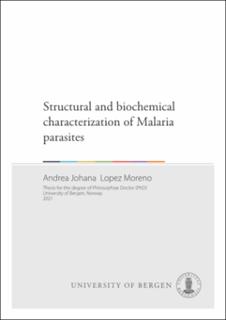| dc.contributor.author | Lopez Moreno, Andrea Johana | |
| dc.date.accessioned | 2021-09-07T12:51:28Z | |
| dc.date.available | 2021-09-07T12:51:28Z | |
| dc.date.issued | 2021-09-17 | |
| dc.date.submitted | 2021-08-27T12:39:12.261Z | |
| dc.identifier | container/9a/57/0b/04/9a570b04-bb88-4afb-b948-7d2abd5e6d4e | |
| dc.identifier.isbn | 9788230841501 | |
| dc.identifier.isbn | 9788230855195 | |
| dc.identifier.uri | https://hdl.handle.net/11250/2774059 | |
| dc.description.abstract | The Apicomplexa phylum includes more than 6000 species, and some of them are pathogens of humans and animals of socio-economic importance. The most representative parasites are Plasmodium spp. and Toxoplasma gondii. Plasmodium spp. cause malaria, a parasitic infection with a wide distribution in tropical and subtropical areas. These parasites display a unique mode of cell motility called gliding motility. A macromolecular motor complex, the glideosome, is indispensable for parasite locomotion and host cell infection. The core of the glideosome is formed by an actomyosin motor comprised of actin as well as myosin (Myo) A and its two light chains, essential light chain (ELC) and MyoA tail interacting protein (MTIP). Plasmodium spp. have six myosins classified into three classes (VI, XII, and XIV). MyoA from class XIV is the most studied of these. The force for parasite gliding motility is produced by the hydrolysis of ATP, which promotes the movement of MyoA along actin filaments. Plasmodium spp. have two actin isoforms, of which the major isoform, ActI, is the most studied. In this work, a biochemical and structural characterization was performed on Plasmodium falciparum actins, focusing on the minor isoform, ActII. In vitro experiments were performed to understand the polymerization properties of these unconventional actins. The critical concentration, the kinetics of the elongation phase, and spontaneous depolymerization were studied. This thesis work showed that the filament stability of Plasmodium actins is different between the isoforms and from canonical actins. Especially for ActI, which forms shorter filaments than ActII. Atomic structures were determined by cryogenic electron microscopy (cryo-EM) of PfActII in the ADP-Mg2+ form in the absence and presence of the stabilizing agent jasplakinolide (JAS) at resolutions of 3.5 and 3.2 Å, respectively. The structures reveal monomer interactions along the filament, the effect of JAS on the filaments, and conformational changes in the actin protomers upon polymerization, including the D-loop conformation. In addition, this work contributed to obtaining the first high-resolution structure of the Plasmodium actomyosin motor complex at an average resolution of 3.1 Å, and the structure of filamentous PfActI with a resolution of 2.6 Å showing details of the nucleotide and JAS binding sites. Besides, a preliminary characterization of class VI myosins was performed. A molecular tool was generated, which can be used to study protein-protein interactions in order to find the interacting light chains for other Plasmodium myosins. Understanding the structure and biochemical properties of the glideosome components and other actomyosin complexes provides a basis for developing new treatments against these devasting pathogens. | en_US |
| dc.language.iso | eng | en_US |
| dc.publisher | The University of Bergen | en_US |
| dc.relation.haspart | Paper I: Kumpula, EP, Lopez, AJ, Tajedin, L, Han, H, & Kursula, I. (2019). Atomic view into Plasmodium actin polymerization, ATP hydrolysis, and fragmentation. PLoS biol 17(6): e3000315. The article is available at: <a href="https://hdl.handle.net/1956/21604" target="blank">https://hdl.handle.net/1956/21604</a> | en_US |
| dc.relation.haspart | Paper II: Lopez AJ, Vahokoski J, Calder LJ, Rosenthal PB & Kursula I. (2021). Polymerization properties and near-atomic structure of filamentous Plasmodium falciparum actin II. The article is not available in BORA. | en_US |
| dc.relation.haspart | Paper III: Vahokoski J, Calder LJ, Lopez AJ, Molloy JE, Rosenthal PB & Kursula I. (2020). High-resolution structures of malaria parasite actomyosin and actin filaments. The preprint article is available in the thesis file. The preprint article is also available at: <a href=" https://doi.org/10.1101/2020.07.02.183871" target="blank">https://doi.org/10.1101/2020.07.02.183871</a> | en_US |
| dc.rights | In copyright | |
| dc.rights.uri | http://rightsstatements.org/page/InC/1.0/ | |
| dc.subject | actin | en_US |
| dc.subject | Apicomplexa | en_US |
| dc.subject | cryo-EM | en_US |
| dc.subject | filament | en_US |
| dc.subject | glideosome | en_US |
| dc.subject | jasplakinolide | en_US |
| dc.subject | malaria | en_US |
| dc.subject | myosin | en_US |
| dc.title | Structural and biochemical characterization of Malaria parasites | en_US |
| dc.type | Doctoral thesis | en_US |
| dc.date.updated | 2021-08-27T12:39:12.261Z | |
| dc.rights.holder | Copyright the Author. All rights reserved | en_US |
| dc.contributor.orcid | https://orcid.org/0000-0001-8956-3931 | |
| dc.description.degree | Doktorgradsavhandling | |
| fs.unitcode | 13-14-0 | |
